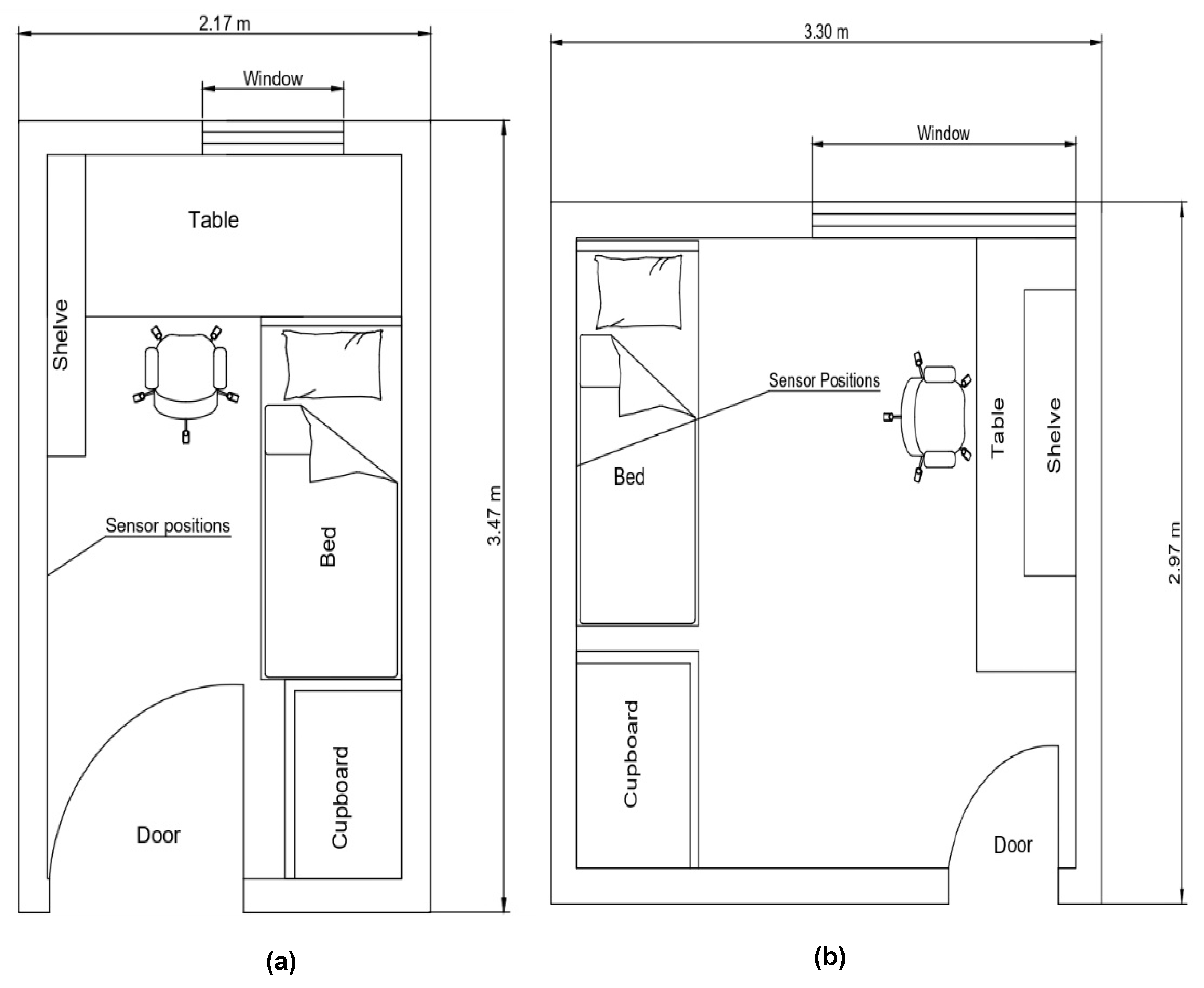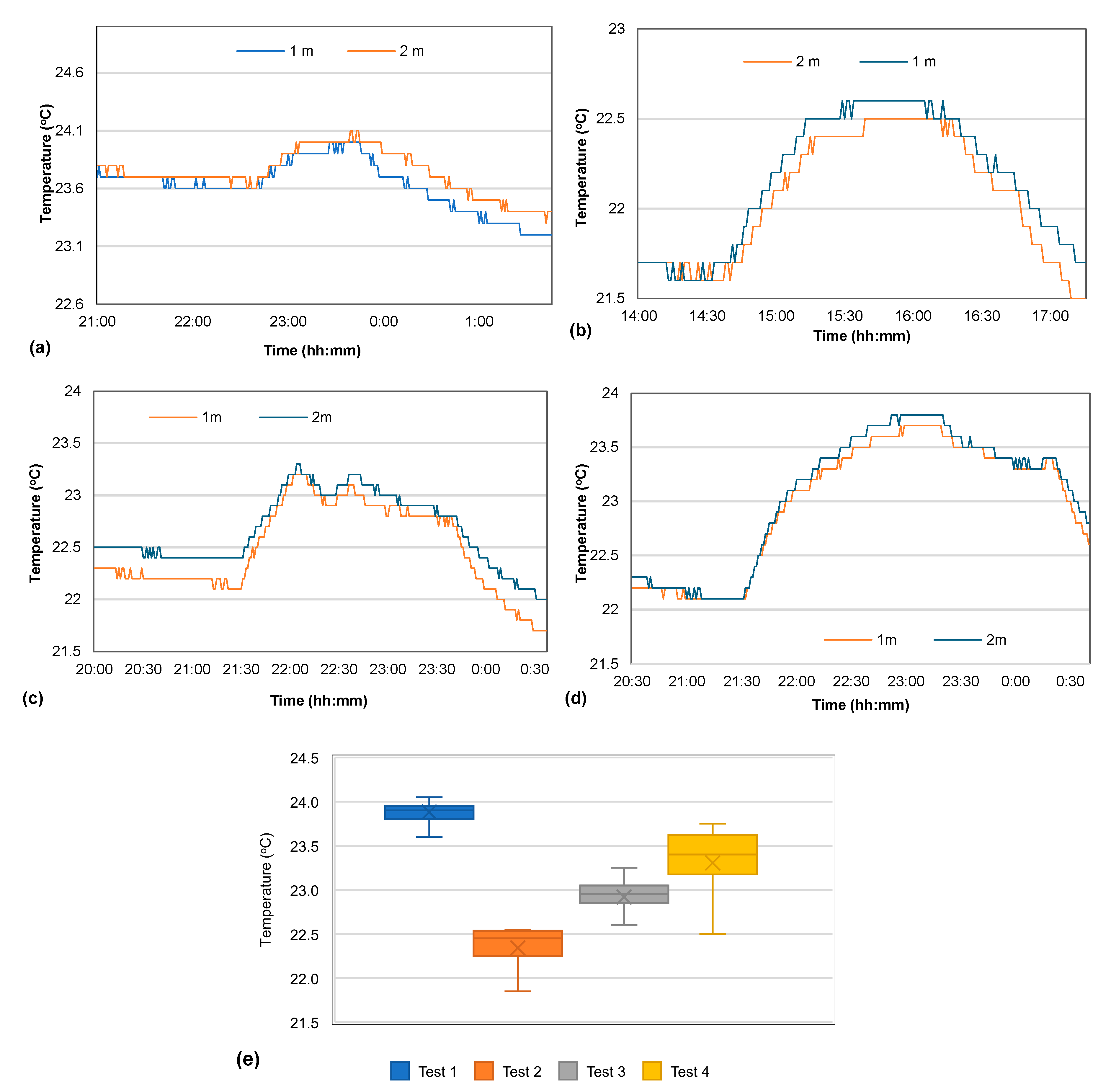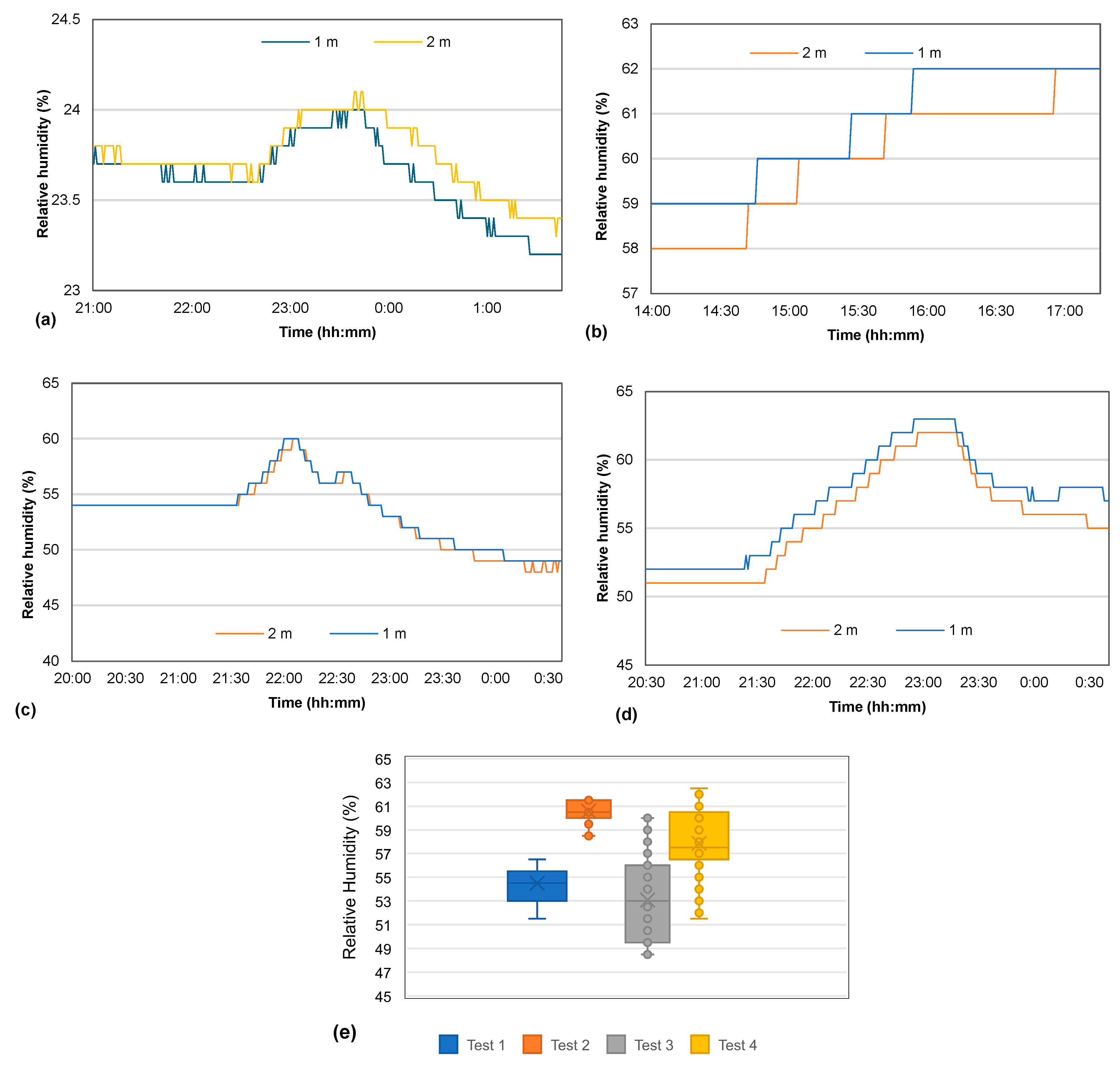Investigating the Effects of Occupancy and Natural Ventilation on the Indoor Air Quality of Dormitories in Cold Regions
Abstract
1. Introduction
2. Materials and Methods
2.1. Methodological Approach
2.2. Study Area
2.3. Carbon Dioxide Monitoring
2.4. Air Exchange Rate
2.5. Mass Balance for CO2 Estimation
2.6. CO2 Generation Rates
3. Results
3.1. CO2 Monitoring
3.2. Temperature
3.3. Relative Humidity
3.4. Impact of Natural Ventilation
4. Discussion
5. Conclusions
Author Contributions
Funding
Data Availability Statement
Acknowledgments
Conflicts of Interest
Abbreviations
| ANOVA | Analysis of variance |
| HVAC | Heating, ventilation, and air conditioning |
| IAQ | Indoor air quality |
| NVT | Natural ventilation time |
| OP | Number of occupants |
| RH | Relative humidity |
| WHO | World Health Organization |
Appendix A. Analysis of Variance Results
| Source of Variation | SS | df | MS | F | p-Value | F Crit |
|---|---|---|---|---|---|---|
| Between Groups | 1.69 × 108 | 2 | 84,400,821.2 | 138.7871 | 2.49 × 10−49 | 3.012475 |
| Within Groups | 3.27 × 108 | 538 | 608,131.737 | |||
| Total | 4.96 × 108 | 540 |
| Source of Variation | SS | df | MS | F | p-Value | F Crit |
|---|---|---|---|---|---|---|
| Between Groups | 1.72 × 108 | 2 | 85,825,675 | 145.7858 | 2.56 × 10−51 | 3.012475 |
| Within Groups | 3.17 × 108 | 538 | 588,710.6 | |||
| Total | 4.88 × 108 | 540 |
References
- Odeh, I.; Hussein, T. Activity pattern of urban adult students in an eastern mediterranean society. Int. J. Environ. Res. Public Health 2016, 13, 960. [Google Scholar] [CrossRef]
- Leech, J.A.; Nelson, W.C.; Burnett, R.T.; Aaron, S.; Raizenne, M.E. It’s about time: A comparison of Canadian and American time–activity patterns. J. Expo. Sci. Environ. Epidemiol. 2002, 12, 427–432. [Google Scholar] [CrossRef] [PubMed]
- Ekmekcioglu, D.; Keskin, S.S. Characterization of Indoor Air Particulate Matter in selected elementary schools in Istanbul, Turkey. Indoor Built Environ. 2007, 16, 169–176. [Google Scholar] [CrossRef]
- Ipsen, C.; van Veldhoven, M.; Kirchner, K.; Hansen, J.P. Six key advantages and disadvantages of working from home in Europe during COVID-19. Int. J. Environ. Res. Public Health 2021, 18, 1826. [Google Scholar] [CrossRef] [PubMed]
- Grant, C. The UK Is the Work-from-Home Capital of Europe. Now Let’s Work on Getting It Right. 2023. Available online: https://www.theguardian.com/commentisfree/2023/jul/31/uk-work-from-home-capital-europe-make-sure-do-it-right (accessed on 1 November 2023).
- Tran, V.V.; Park, D.; Lee, Y.-C. Indoor air pollution, related human diseases, and recent trends in the control and improvement of Indoor Air Quality. Int. J. Environ. Res. Public Health 2020, 17, 2927. [Google Scholar] [CrossRef]
- WHO. Household Air Pollution, World Health Organization. World Health Organization. 2022. Available online: https://www.who.int/news-room/fact-sheets/detail/household-air-pollution-and-health (accessed on 17 April 2023).
- Deng, H.Y.; Feng, Z.; Cao, S.-J. Influence of air change rates on indoor CO2 stratification in terms of Richardson number and vorticity. Build. Environ. 2018, 129, 74–84. [Google Scholar] [CrossRef]
- Lowther, S.D.; Dimitroulopoulou, S.; Foxall, K.; Shrubsole, C.; Cheek, E.; Gadeberg, B.; Sepai, O. Low level carbon dioxide indoors—A pollution indicator or a pollutant? A health-based perspective. Environments 2021, 8, 125. [Google Scholar] [CrossRef]
- Chatzidiakou, L.; Mumovic, D.; Summerfield, A. Is CO2 a good proxy for indoor air quality in classrooms? Part 1: The interrelationships between thermal conditions, CO2 levels, ventilation rates and selected indoor pollutants’. Build. Serv. Eng. Res. Technol. 2015, 36, 129–161. [Google Scholar] [CrossRef]
- BS EN 16798-1:2019; Energy Performance of Buildings—Ventilation for Buildings—Part 1: Indoor Environmental Input Parameters for Design and Assessment of Energy Performance of Buildings Addressing Indoor Air Quality, Thermal Environment, Lighting and Acoustics—Module M1-6. BSI: London, UK, 2019; ISBN 978-0-580-07090-3. Available online: https://webstore.ansi.org/preview-pages/BSI/preview_30297474.pdf (accessed on 17 June 2023).
- Apte, M.G.; Fisk, W.J.; Daisey, J.M. Associations between indoor CO2 concentrations and sick building syndrome symptoms in US office buildings: An analysis of the 1994–1996 base study data. Indoor Air 2000, 10, 246–257. [Google Scholar] [CrossRef]
- Azuma, K.; Kagi, N.; Yanagi, U.; Osawa, H. Effects of low-level inhalation exposure to carbon dioxide in Indoor Environments: A short review on human health and psychomotor performance. Environ. Int. 2018, 121, 51–56. [Google Scholar] [CrossRef]
- ASHRAE. Position Document on Indoor Carbon Dioxide Ashrae.org. 2022. Available online: https://www.ashrae.org/file%20library/about/position%20documents/pd_indoorcarbondioxide_2022.pdf (accessed on 2 June 2023).
- HSE UK. Ventilation in the Workplace, Health and Safety Executive. Available online: https://www.hse.gov.uk/ventilation/using-CO2-monitors.htm (accessed on 2 June 2023).
- Asif, A.; Zeeshan, M. Comparative analysis of indoor air quality in offices with different ventilation mechanisms and simulation of ventilation process utilizing system dynamics tool. J. Build. Eng. 2023, 72, 106687. [Google Scholar] [CrossRef]
- Jiang, J.; Wang, D.; Liu, Y.; Di, Y.; Liu, J. A holistic approach to the evaluation of the indoor temperature based on thermal comfort and learning performance. Build. Environ. 2021, 196, 107803. [Google Scholar] [CrossRef]
- Alsmo, T.; Alsmo, C. Ventilation and relative humidity in Swedish buildings. J. Environ. Prot. 2014, 5, 1022–1036. [Google Scholar] [CrossRef]
- Szczurek, A.; Maciejewska, M.; Pietrucha, T. Occupancy determination based on time series of CO2 concentration, temperature and relative humidity. Energy Build. 2017, 147, 142–154. [Google Scholar] [CrossRef]
- Duarte, C.; Van Den Wymelenberg, K.; Rieger, C. Revealing occupancy patterns in an office building through the use of occupancy sensor data. Energy Build. 2013, 67, 587–595. [Google Scholar] [CrossRef]
- Mahyuddin, N.; Awbi, H.B. The spatial distribution of carbon dioxide in an environmental test chamber. Build. Environ. 2010, 45, 1993–2001. [Google Scholar] [CrossRef]
- Liu, S.; Yoshino, H.; Mochida, A. A measurement study on the indoor climate of a college classroom. Int. J. Vent. 2011, 10, 251–261. [Google Scholar] [CrossRef]
- Mohamed, S.; Rodrigues, L.; Omer, S.; Calautit, J. Overheating and indoor air quality in primary schools in the UK. Energy Build. 2021, 250, 111291. [Google Scholar] [CrossRef]
- Lama, S.; Fu, C.; Lee, A. Indoor Air Quality (IAQ) evaluation of Higher Education Learning environments. J. Constr. Res. 2021, 4. [Google Scholar] [CrossRef]
- Sakamoto, M.; Li, M.; Kuga, K.; Ito, K.; Bekö, G.; Williams, J.; Wargocki, P. CO2 emission rates from sedentary subjects under controlled laboratory conditions. Build. Environ. 2022, 211, 108735. [Google Scholar] [CrossRef]
- McLeod, R.S.; Mathew, M.; Salman, D.; Thomas, C.L.P. An investigation of indoor air quality in a recently refurbished educational building. Front. Built Environ. 2022, 7, 769761. [Google Scholar] [CrossRef]
- Zuhaib, S.; Manton, R.; Griffin, C.; Hajdukiewicz, M.; Keane, M.M.; Goggins, J. An Indoor Environmental Quality (IEQ) assessment of a partially-retrofitted University Building. Build. Environ. 2018, 139, 69–85. [Google Scholar] [CrossRef]
- Persily, A.; de Jonge, L. Carbon dioxide generation rates for building occupants. Indoor Air 2017, 27, 868–879. [Google Scholar] [CrossRef]
- Huang, Q.; Syndicus, M.; Ehrt, R.; Sacic, A.; Frisch, J.; van Treeck, C. Development of a CO2 based indoor air quality measurement box for classrooms. In Proceedings of the 18th Healthy Buildings Europe Conference, Aachen, Germany, 11–14 June 2023; pp. 1–7. [Google Scholar]
- Bhagat, R.K.; Wykes, M.S.D.; Dalziel, S.B.; Linden, P.F. Effects of ventilation on the indoor spread of Covid-19. J. Fluid Mech. 2020, 903, F1. [Google Scholar] [CrossRef]
- Wang, L.; Zhang, X.; Qi, D. Indoor thermal stratification and its statistical distribution. Indoor Air 2018, 29, 347–363. [Google Scholar] [CrossRef]
- Seduikyte, L.; Stasiulienė, L.; Prasauskas, T.; Martuzevičius, D.; Černeckienė, J.; Ždankus, T.; Dobravalskis, M.; Fokaides, P. Field measurements and numerical simulation for the definition of the thermal stratification and ventilation performance in a mechanically ventilated sports hall. Energies 2019, 12, 2243. [Google Scholar] [CrossRef]
- Di Gilio, A.; Palmisani, J.; Pulimeno, M.; Cerino, F.; Cacace, M.; Miani, A.; de Gennaro, G. CO2 Concentration Monitoring Inside Educational Buildings as a strategic tool to reduce the risk of SARS-COV-2 airborne transmission. Environ. Res. 2021, 202, 111560. [Google Scholar] [CrossRef] [PubMed]
- Peng, Z.; Jimenez, J.L. Exhaled CO2 as a COVID-19 infection risk proxy for different indoor environments and activities. Environ. Sci. Technol. Lett. 2021, 8, 392–397. [Google Scholar] [CrossRef]
- Sadrizadeh, S.; Yao, R.; Yuan, F.; Awbi, H.; Bahnfleth, W.; Bi, Y.; Cao, G.; Croitoru, C.; de Dear, R.; Haghighat, F.; et al. Indoor Air Quality and health in schools: A critical review for developing the roadmap for the Future School Environment. J. Build. Eng. 2022, 57, 104908. [Google Scholar] [CrossRef]
- Coley, D.A.; Greeves, R.; Saxby, B.K. The effect of low ventilation rates on the cognitive function of a primary school class. Int. J. Vent. 2007, 6, 107–112. [Google Scholar] [CrossRef]
- Awang, N.R.; Ridzuan, A.S.; Zainol, M.H. Background concentration of indoor air quality in hostel rooms during varying conditions. J. Trop. Resour. Sustain. Sci. (JTRSS) 2018, 6, 100–108. [Google Scholar] [CrossRef]
- Korsavi, S.S.; Montazami, A.; Mumovic, D. Indoor Air Quality (IAQ) in naturally-ventilated primary schools in the UK: Occupant-related factors. Build. Environ. 2020, 180, 106992. [Google Scholar] [CrossRef]
- Lei, Z.; Liu, C.; Wang, L.; Li, N. Effect of natural ventilation on indoor air quality and thermal comfort in dormitory during winter. Build. Environ. Vol. 2017, 125, 240–247. [Google Scholar] [CrossRef]
- McGill, G.; Oyedele, L.O.; McAllister, K. Case study investigation of indoor air quality in mechanically ventilated and naturally ventilated UK social housing. Int. J. Sustain. Built Environ. 2015, 4, 58–77. [Google Scholar] [CrossRef]
- Tognon, G.; Marigo, M.; De Carli, M.; Zarrella, A. Mechanical, natural and hybrid ventilation systems in different building types: Energy and indoor air quality analysis. J. Build. Eng. 2023, 76, 107060. [Google Scholar] [CrossRef]
- Ródenas García, M.; Spinazzé, A.; Branco, P.T.B.S.; Borghi, F.; Villena, G.; Cattaneo, A.; Di Gilio, A.; Mihucz, V.G.; Gómez Álvarez, E.; Lopes, S.I.; et al. Review of low-cost sensors for indoor air quality: Features and applications. Appl. Spectrosc. Rev. 2022, 57, 747–779. [Google Scholar] [CrossRef]
- Mahyuddin, N.; Awbi, H.B. A Review of CO2 Measurement Procedures in Ventilation Research. Int. J. Vent. 2016, 10, 353–370. [Google Scholar] [CrossRef]
- International WELL Building. Ventilation Effectiveness. 2020. Available online: https://standard.wellcertified.com/air/ventilation-effectiveness (accessed on 19 November 2023).
- Palmisani, J.; Di Gilio, A.; Viana, M.; de Gennaro, G.; Ferro, A. Indoor Air Quality Evaluation in oncology units at two European hospitals: Low-cost sensors for TVOCs, PM2.5 and CO2 Real-time monitoring. Build. Environ. 2021, 205, 108237. [Google Scholar] [CrossRef]
- Pei, G.; Rim, D.; Schiavon, S.; Vannucci, M. Effect of sensor position on the performance of CO2-based demand controlled ventilation. Energy Build. 2019, 202, 109358. [Google Scholar] [CrossRef]
- Hattori, S.; Iwamatsu, T.; Miura, T.; Tsutsumi, F.; Tanaka, N. Investigation of indoor air quality in residential buildings by measuring CO2 concentration and a questionnaire survey. Sensors 2022, 22, 7331. [Google Scholar] [CrossRef]
- Kiwan, A.; Berg, W.; Fiedler, M.; Ammon, C.; Gläser, M.; Müller, H.J.; Brunsch, R. Air exchange rate measurements in naturally ventilated dairy buildings using the tracer gas decay method with 85Kr, compared to CO2 mass balance and discharge coefficient methods. Biosyst. Eng. 2013, 116, 286–296. [Google Scholar] [CrossRef]
- ASHRAE Standard 62.1–2016; Ventilation for Acceptable Indoor Air Quality. American Society of Heating, Refrigerating, and Air-Conditioning Engineers: Peachtree Corners, GA, USA, 2016.
- ARANET. Aranet4—CO2 Monitor, Aranet. 2023. Available online: https://pro.aranet.com/products/aranet4/ (accessed on 26 January 2024).
- Kalimeri, K.K.; Saraga, D.E.; Lazaridis, V.D.; Legkas, N.A.; Missia, D.A.; Tolis, E.I.; Bartzis, J.G. Indoor air quality investigation of the school environment and estimated health risks: Two-season measurements in primary schools in Kozani, Greece. Atmos. Pollut. Res. 2016, 7, 1128–1142. [Google Scholar] [CrossRef]
- Jung, C.-C.; Wu, P.-C.; Tseng, C.-H.; Su, H.-J. Indoor air quality varies with ventilation types and working areas in hospitals. Build. Environ. 2015, 85, 190–195. [Google Scholar] [CrossRef]
- Zhou, L.; Sun, W.; Huang, C.; Li, H.; Zou, Z.; Wu, C. Studies on comparison of Particle Concentration Models for cleanroom. Procedia Eng. 2017, 205, 3308–3315. [Google Scholar] [CrossRef]
- Reda, I.; AbdelMessih, R.N.; Steit, M.; Mina, E.M. Exhaled CO2-based tracer gas for measuring ventilation rates and energy consumption with application to worship places. Ain Shams Eng. J. 2023, 14, 102138. [Google Scholar] [CrossRef]
- Fujikawa, M.; Yoshino, H.; Takaki, R.; Okuyama, H.; Hayashi, M.; Sugawara, M. Experimental study of the multi-zonal airflow measurement method using human expiration. J. Environ. Eng. (Trans. AIJ) 2010, 75, 499–508. [Google Scholar] [CrossRef][Green Version]
- Lawrence, T.M.; Braun, J.E. A methodology for estimating occupant CO2 source generation rates from measurements in small commercial buildings. Build. Environ. 2007, 42, 623–639. [Google Scholar] [CrossRef]
- Fan, G.; Chang, H.; Sang, C.; Chen, Y.; Ning, B.; Liu, C. Evaluating indoor carbon dioxide concentration and ventilation rate of research student offices in Chinese universities: A case study. Processes 2022, 10, 1434. [Google Scholar] [CrossRef]
- Ahn, K.U.; Kim, D.-W.; Cho, K.; Cho, D.; Cho, H.M.; Chae, C.-U. Hybrid model for forecasting indoor CO2 Concentration. Buildings 2020, 12, 1540. [Google Scholar] [CrossRef]
- ASHRAE. ASHRAE Handbook Fundamentals; ASHRAE: Atlanta, GA, USA, 2013. [Google Scholar]
- Cosals. Available online: https://www.casals.com/en/ventilation-tools/calculation-help/air-change-rates-in-typical-rooms-and-buildings/ (accessed on 23 October 2023).
- Fonseca, A.; Abreu, I.; Guerreiro, M.J.; Abreu, C.; Silva, R.; Barros, N. Indoor air quality and sustainability management—Case study in three Portuguese healthcare units. Sustainability 2018, 11, 101. [Google Scholar] [CrossRef]
- Persily, A.K.; Polidoro, B. Indoor Carbon Dioxide Metric Analysis Tool. In Building Energy and Environment Division Engineering Laboratory; National Institute of Standards and Technolog: Gaithersburg, MD, USA, 2022. [Google Scholar] [CrossRef]
- HSE UK. OC 311/2: Sick Building Syndrome, OC 311/2: Sick Building Syndrome. 1992. Available online: https://www.hse.gov.uk/foi/internalops/ocs/300-399/oc311_2.htm (accessed on 28 January 2024).
- Hiwar, W.; King, M.F.; Shuweihdi, F.; Fletcher, L.A.; Dancer, S.J.; Noakes, C.J. What is the relationship between indoor air quality parameters and airborne microorganisms in hospital environments? A systematic review and meta-analysis. Indoor Air 2021, 31, 1308–1322. [Google Scholar] [CrossRef] [PubMed]
- Persily, A.K. Field measurement of ventilation rates. Indoor Air 2016, 26, 97–111. [Google Scholar] [CrossRef] [PubMed]
- Batog, P.; Badura, M. Dynamic of changes in carbon dioxide concentration in bedrooms. Procedia Eng. 2013, 57, 175–182. [Google Scholar] [CrossRef]
- Qi, M.W.; Li, X.F.; Weschler, L.B.; Sundell, J. CO2 generation rate in Chinese people. Indoor Air 2014, 24, 559–566. [Google Scholar] [CrossRef]
- Nusseck, M.; Richter, B.; Holtmeier, L.; Skala, D.; Spahn, C. CO2 measurements in instrumental and vocal closed room settings as a risk reducing measure for a Coronavirus infection. medRxiv 2020, 2020-10. [Google Scholar] [CrossRef]
- Pereira, P.F.; Ramos, N.M.M.; Almeida, R.M.S.F.; Simões, M.L.; Barreira, E. Occupant influence on residential ventilation patterns in mild climate conditions. Energy Procedia 2017, 132, 837–842. [Google Scholar] [CrossRef]






| Occupancy | Test Location | Room Size (m × m × m) | Number of Windows | Window Size (m2) | Room Area (m2) | Room Volume (m3) | Sensor Location |
|---|---|---|---|---|---|---|---|
| 1 | Room A | 3.47 × 2.17 × 2.38 | 2 | 1.67 1 | 7.52 | 17.92 | Wall mounted |
| 2 | Room B | 3.30 × 2.97 × 2.97 | 1 | 1.67 1 | 9.80 | 29.10 | Wall mounted |
| 3 | Room B | 3.30 × 2.97 × 2.97 | 1 | 1.67 1 | 9.80 | 29.10 | Wall mounted |
| 4 | Room B | 3.30 × 2.97 × 2.97 | 1 | 1.67 1 | 9.80 | 29.10 | Wall mounted |
| Test No. | Room No. | Occupancy (n) | Air Exchange Rate ERs “N” (h−1) | Average CO2 Generation Rate Per Person “E” (L/s) |
|---|---|---|---|---|
| Test 1 | A | 1 | 0.12 | 0.0106 |
| Test 2 | B | 2 | 0.16 | 0.0035 |
| Test 3 | B | 3 | 0.16 | 0.0017 |
| Test 4 | B | 4 | 0.37 | 0.0020 |
Disclaimer/Publisher’s Note: The statements, opinions and data contained in all publications are solely those of the individual author(s) and contributor(s) and not of MDPI and/or the editor(s). MDPI and/or the editor(s) disclaim responsibility for any injury to people or property resulting from any ideas, methods, instructions or products referred to in the content. |
© 2025 by the authors. Licensee MDPI, Basel, Switzerland. This article is an open access article distributed under the terms and conditions of the Creative Commons Attribution (CC BY) license (https://creativecommons.org/licenses/by/4.0/).
Share and Cite
Nasir, I.; Haider, H.; Shafiquzzaman, M.; Alinizzi, M.; Hu, G.; Ghumman, A.R. Investigating the Effects of Occupancy and Natural Ventilation on the Indoor Air Quality of Dormitories in Cold Regions. Buildings 2025, 15, 896. https://doi.org/10.3390/buildings15060896
Nasir I, Haider H, Shafiquzzaman M, Alinizzi M, Hu G, Ghumman AR. Investigating the Effects of Occupancy and Natural Ventilation on the Indoor Air Quality of Dormitories in Cold Regions. Buildings. 2025; 15(6):896. https://doi.org/10.3390/buildings15060896
Chicago/Turabian StyleNasir, Irfan, Husnain Haider, Md. Shafiquzzaman, Majed Alinizzi, Guangji Hu, and Abdul Razzaq Ghumman. 2025. "Investigating the Effects of Occupancy and Natural Ventilation on the Indoor Air Quality of Dormitories in Cold Regions" Buildings 15, no. 6: 896. https://doi.org/10.3390/buildings15060896
APA StyleNasir, I., Haider, H., Shafiquzzaman, M., Alinizzi, M., Hu, G., & Ghumman, A. R. (2025). Investigating the Effects of Occupancy and Natural Ventilation on the Indoor Air Quality of Dormitories in Cold Regions. Buildings, 15(6), 896. https://doi.org/10.3390/buildings15060896









